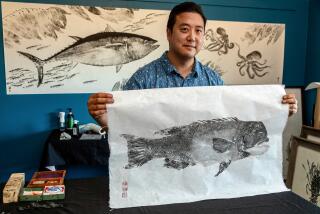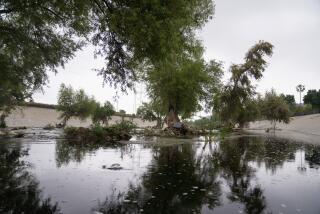Cutter’s Way : Ralph Cutter is into fly-fishing--really, <i> really </i> into fly-fishing. He lives and breathes trout. And now, he’s sharing his passion.
- Share via
TRUCKEE, Calif. — Five hours into Ralph Cutter’s two-day fly-fishing class, a woman’s jaw goes slack. “My gawd!” she yelps. “You’re really into this!”
Cutter pauses. With a digital tensile scale dangling from one hand, the fishing line whose strength he is about to test in another, he lets a sliver of boyish grin crack his face.
Other students, however, fix the woman with stares that say: “Duh!”
Most, after all, had noticed a bit sooner that Cutter’s into- itiveness is on a different order, even for this notoriously obsession-prone pastime.
What tipped them off? How about:
* The way Cutter blurts, “I like bugs!” and explicates, “Without flies, there would be no fly-fishing,” as he shows detailed charts depicting metamorphic cycles of aquatic insects.
* The way his eyes bulge troutlike as he wriggles a stuffed fabric fish around the room, imagining that the fish is hungry and that the ceiling is the river’s bug-covered surface.
* His enthusiasm as he superimposes graphs on an overhead projector, demonstrating the precise point at which a stream’s or lake’s oxygenation level and water temperature combine to create optimum conditions for a trout’s metabolism.
* The quaver in his voice as he rallies the class to watch an emerging mayfly in the insect-breeding aquarium in the kitchen.
* The photograph above that aquarium of a hefty Yucatan crocodile Cutter hooked on a colorful dry fly.
* His insistence that students kneel on the floor to get a fish-eye view as he sprinkles nutritionally correct crickets into a tank containing a gorgeous Golden Trout.
* The story of that trout’s genesis:
“About three years ago, I wanted to get photographs of an egg evolving, from the time it’s fertilized till the time the head pokes out,” Cutter says. “We hiked up to the headwaters of the Kern River. I had a little net, and caught a male and a female trout.
“I took the female trout, and gently squeezed her flanks, till the eggs came out into a Sierra cup. Then I took the male and squeezed out the sperm. I swirled them together and let them sit for 24 hours in the river. Then I put the eggs in a water bottle, packed them in snow and hiked out. . . . One survived.”
So, yes, Ralph Cutter would seem to be into fly-fishing.
That settled, though, students may well light upon another, bigger question. It’s one they may also ask of themselves sometime during his $395 “Complete Fly Fishing” course:
Why?
“There’s something about fly-fishing that’s esoteric and cool,” Cutter says, his fingers sparring nimbly with a wisp of knot that a hot, pine-scented wind is determined to confuse.
But that’s not the real answer.
*
Ralph, 39, and his wife Lisa, 38, run their California School of Fly Fishing in the modern, two-story, solar-heated home that Lisa designed and her brother built, on three pine- and fir-covered acres outside the Tahoe-area town of Truckee.
As Ralph teaches, his daughter Teal, 11, ferries a basket of mini-muffins to each of the 10 students. Her 9-year-old sister, Haley, hovers on the periphery, utterly at ease with the strangers in her house.
About the only wall or shelf in the home not dominated by trout paintings and bric-a-brac is the one featuring old family photographs--and the ubiquitous motif creeps in here too.
One photo, from 1910, shows Cutter’s great-grandfather, Ed, a Fresno-area veterinary pharmacist, with his three sons, in the Kennedy Meadows area of the Eastern Sierra. All clutch fly rods.
Ed explored and mapped parts of the Sierra. He also loaded mules with milk cans full of trout and planted the range’s high, barren lakes. His three sons followed the same path, and their trips inspired two inventions that became as requisite in backpacks as gorp: Cutter’s Insect Repellent and Cutter’s Snake Bite Kits.
The oldest of five boys, Ralph spent his first six years on the Cutter family’s huge ranch, in the rolling oak hills east of San Francisco.
His mother, a devout kayaker, pioneered numerous stretches of California white water and chaired the rivers section of her Sierra Club chapter. She and Ralph’s father--a successful businessman who created the Medfly trap, among other inventions--regularly dragged their kids into the Sierra on horse-packing trips. That wasn’t Ralph’s only early exposure to fish, though.
In the spring, cutthroat trout battled their way up Bear Creek, from San Francisco Bay into the valley spanned by the Cutters’ land. Then, when Ralph was 6, the utility district forced the family to sell. The dammed creek became a reservoir. The spawning run died.
The effect of that incident resurfaced years later, in the vanity plate on Cutter’s Ford pickup: “BOMADAM.”
Long before he bought that plate, though, there was evidence of riparian influence on his life.
After high school, Cutter migrated through three junior colleges. “I would take all the biology courses I could, until they kicked me out. . . . I didn’t want to be a marine biologist. I wanted to know about stuff that lives in the water.”
At Diablo Valley College, in the East Bay, he met Lisa.
“The first time he asked me out, he wanted to go camping,” Lisa says. “I said, ‘No, I’d like to get to know you better.’ ”
So they went sky diving.
They married nine months later. For their honeymoon, they loaded up with fishing, rock-climbing and camera gear, and set off on a nine-month hike north from the Mexican border.
They hit the Sierra Nevada in mid-May and began “windshield wipering” their way back and forth across the range.
It was Lisa’s first backpacking trip, and a good test of their marriage. In the span of one week, they hitchhiked to Bakersfield for supplies and wound up sleeping for three nights under a flickering neon sign that read, “Let’s Eat!” The next day they hiked back into the high country and got caught in a homicidal snowstorm that forced them to ration their food.
“We found a cave and camped in it for five days, counting the number of species of lichen on the wall. We had a wonderful time,” Cutter says.
Lisa recalls the adventure fondly, if less ebulliently: “It was one of those experiences that change your life.”
The trip ended near Lake Tahoe, where Cutter worked his way into a job as a firefighter and paramedic. Today he puts in 24-hour shifts that leave 240 days a year for other pursuits.
His re-immersion into fishing came in the late ‘70s, when he and Lisa took a class with legendary fly-caster Mel Krieger.
What impressed Krieger most about Ralph was his “gentle nature.”
It was another quality, however, that pushed Cutter’s fusion with fly-fishing.
“When Ralph gets into something, he goes full force,” Lisa says with obvious admiration. “He’s always been like that. He wants to know everything there is to know. He gets totally submerged.”
Cutter explains: “I wanted to learn about how trout see, so I went into the computer and found that the best research library was Scripps in La Jolla. I went down there and read every paper ever written on trout vision. Then I interviewed the people who wrote the papers. I cleaned their minds, sat in their classes, went on field trips with them. . . .”
What he learned there, and similar scientific arcana from the fields of limnology, hydrology, entomology, morphology and genetics, fill his classes--which move from the classroom to lakes or streams and back again. Such insight has also turned his “Sierra Trout Guide” (Frank Amato Publications, 1991) into a cult favorite.
Of course, where devotees see a guru, some observers see frivolity--stunning quantities of time and money wasted probing the behavior of dumb creatures that will be caught and immediately released.
But Paul Quinnett, a clinical psychologist in Spokane, Wash., bristles at the notion that fly-fishing is an irrational obsession. In his book “Pavlov’s Trout” (Keokee Co., 1994) he argues that people who fish often enjoy unusually good mental health. And guides tend to be happier than most.
“People who devote themselves to the thing they’re most passionate about--artists, athletes--if they can find a way to make a living at it, that’s the best possible world.”
These days, Cutter limits his guiding to the high Sierra or exotic waters, such as the Amazon. Lisa, meanwhile, guides in the Tahoe area several days a week, and she and Teal will lead a horse-pack trip for mothers and daughters into the Sierra this August.
Sometimes, students from the city comment that the family’s life looks perfect.
“If it weren’t,” Cutter says, “We’d change it.”
*
The epigram to “Sierra Trout Guide’s” first chapter is from Izaak Walton’s 1653 classic, “The Compleat Angler”:
“Rivers and the inhabitants of the watery element were made for wise men to contemplate and fools to pass by without consideration.”
Walton had nothing to say about folks who actually climb in with the fish.
But on the Monday after his weekend class, with his students scattered back to their lives as oncologists, designers and attorneys, Cutter makes the five-minute drive down to a spot where the Truckee River runs alongside an old coolie-built railroad abutment.
Pulling on a dry-suit and air tanks, he sloshes in, disappearing into a shattered reflection of brush, trees and blue sky. Inscrutable from the bank, the river now becomes the dynamic ecosystem Cutter described in the classroom. Crayfish scuttle around submerged rocks. Caddis fly larvae, encased like hermit crabs in clusters of pebbles, pulse in the current beside puffy white snail eggs.
And there, flashing across murky pools, or finning calmly beneath a foaming riffle, big trout, invisible from above, go about their lives.
In the past decade, Cutter has spent hundreds of hours snorkeling and scuba diving in streams, rivers and lakes. Only from within, he says, can he put the finishing touches on his picture of the river realm.
Cutter’s flyers boast that his classes will push students into the ranks of “the 10% of anglers who catch 90% of the fish.”
Increasingly, though, as he reels in more clients than he can handle, he is equally intent on releasing them with a new ethic, he says.
After watching him clip off the whole hook on a hand-tied fly before casting; after hearing him argue against the way some angling advocacy groups turn rivers into “pee-wee golf courses for fishermen,” students may well wonder on which side of the water’s surface Cutter’s true loyalties lie.
“Lisa and I sit and talk about how to approach students,” Cutter concedes. “We discuss how to teach them how neat fishing is without turning them off by talking about Zen, or about how nice it is to go fishing and not catch a fish. Until you feel it, and experience it, you’ll never understand what I’m trying to say.
“There’s an art and there’s a science to fishing,” he continues. “I try to teach the science, and I think the art follows. . . .
“Very, very often, Lisa and I go fishing--and never go fishing. We get down to the river with our fishing rods, sit down on the bank, and just watch--watch the fish rise, watch the bugs hatch, watch the moon come over the water. . . .”
More to Read
Sign up for The Wild
We’ll help you find the best places to hike, bike and run, as well as the perfect silent spots for meditation and yoga.
You may occasionally receive promotional content from the Los Angeles Times.






